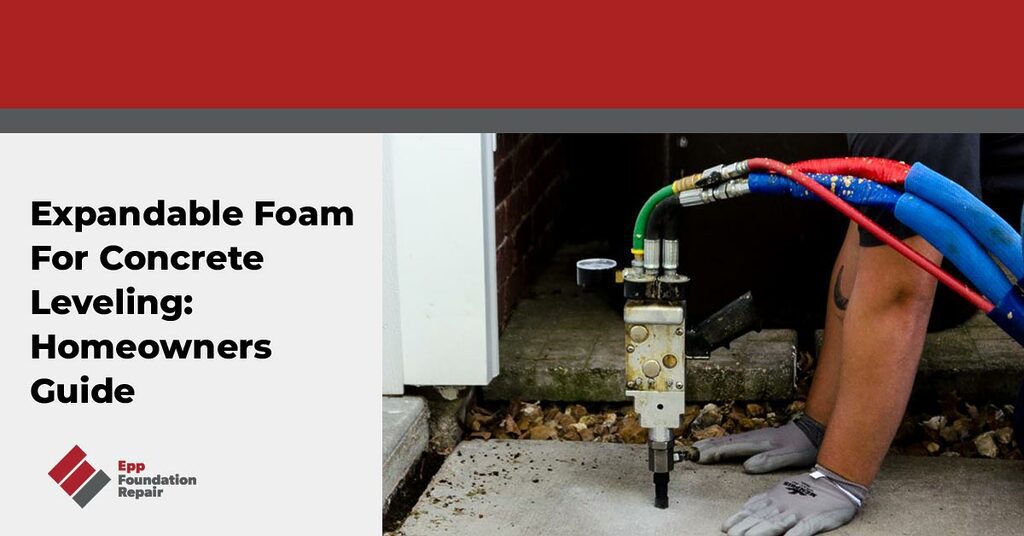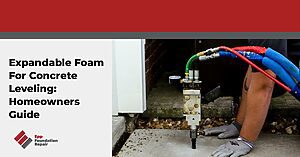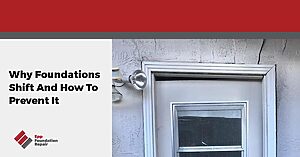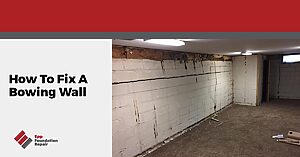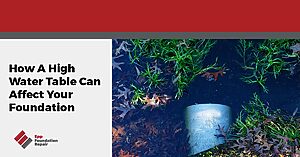Over time, even the sturdiest concrete slabs can become uneven, leading to many problems. If you’re a homeowner facing uneven concrete surfaces, fear not. This guide explains how expandable foam can help you level your concrete surfaces seamlessly and effectively.
Why Concrete Slabs Become Uneven
Concrete slabs can become uneven and crack due to several factors:
- Soil erosion: When the soil beneath a concrete slab erodes, it creates voids or gaps, causing the concrete to sink. Weather conditions, such as heavy rain or droughts, can exacerbate this issue, leading to further instability.
- Poor Soil Compaction: If the soil wasn’t adequately compacted before pouring the concrete, it could settle unevenly over time, causing the slab to shift.
- Tree Roots: These can lift or crack the slab, contributing to its unevenness.
- Wear and Tear: Over time, the constant pressure from vehicles, foot traffic, or heavy equipment can cause the concrete to crack and settle unevenly.
- Freezing and Thawing Cycles: In cooler climates, the cycle of freezing and thawing can wreak havoc on concrete slabs. Water seeps into tiny cracks and crevices, and when it freezes, it expands, leading to larger cracks and potential shifting.
- Drought Conditions: Prolonged periods of drought can cause soil to contract and shrink, resulting in gaps under the concrete. When the soil eventually rehydrates, it may not return to its original level, causing instability in the slab.
What Is Expandable Foam For Concrete Leveling?
Expandable foam for concrete leveling, professionally known as polyurethane foam injection or polyjacking, is an innovative solution for fixing uneven surfaces. Unlike traditional methods, such as mudjacking, which uses a slurry of cement and soil, polyjacking employs high-density foam to lift and level the concrete. Polyurethane foam injection involves pumping a two-part liquid polymer into the voids beneath the concrete slab. Once injected, the liquid expands and hardens, filling the gaps and lifting the slab back to its original position. It provides long-lasting support without adding significant weight to the underlying soil. It’s also water-resistant, ensuring the leveled surface remains stable even in wet conditions.
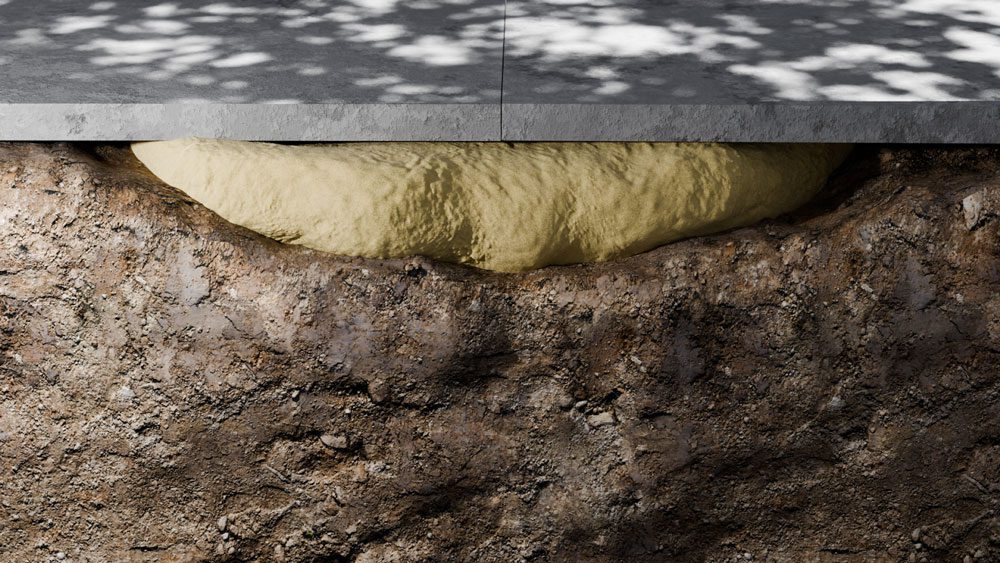
Why Should You Invest In Concrete Leveling?
Investing in concrete leveling is crucial for maintaining the safety and aesthetics of your home. Uneven concrete surfaces can pose significant tripping hazards, especially for children and older people. By leveling the concrete, you can prevent accidents and create a safer environment for your family.
Additionally, uneven concrete can detract from the curb appeal of your home. Whether it’s a sunken driveway, uneven patio, or cracked walkway, these issues can make your property look unkempt and reduce its overall value. Leveling the concrete not only enhances the appearance of your home but also increases its marketability if you decide to sell.
Finally, addressing uneven concrete surfaces can prevent further damage. If left unattended, uneven slabs can worsen over time, leading to more extensive and costly repairs. Investing in concrete leveling early on can save money by avoiding the need for complete slab replacement.
Benefits Of Leveling Concrete With Expandable Foam
Expandable foam offers several advantages over traditional concrete leveling methods. Consider the following advantages:
- Quick and Efficient: Unlike mudjacking, which can take several hours to days to complete, polyjacking can be done in a matter of hours, minimizing disruption to your daily routine.
- Durability: It provides long-lasting support, ensuring the leveled surface remains stable for years.
- Waterproof: Unlike the cement slurry used in mudjacking, polyurethane foam is waterproof, preventing future erosion and settlement issues.
- Minimally Invasive: Since the foam is injected through small holes, there is no need for extensive excavation or heavy machinery. The process is cleaner, quieter, and less intrusive.
- Lightweight: Polyurethane foam is significantly lighter than the cement slurry used in mudjacking, making it ideal for areas where the soil is weak or prone to erosion by reducing the risk of further settlement or shifting.
- Cost-effective: While the initial cost of polyjacking might be higher than traditional lifting methods, it is up to 50% cheaper than slab replacement, and the long-term benefits over traditional lifting methods make it a more cost-effective solution. The durability of the foam ensures fewer repairs in the future, saving you money over time.
By investing in expandable foam for concrete leveling, you’re opting for a method that balances affordability with high performance and longevity.
How To Level Concrete With Expandable Foam
Want to know how the expanding foam works? Here is a step-by-step process:
1. Conduct a thorough inspection:
- A professional assesses the condition of the concrete slab.
- Identifies underlying issues.
- Determines the best approach for leveling.
- Uses specialized equipment to locate voids and measure settlement extent.
2. Begin the installation process:
- Drill small holes into the concrete slab at strategic locations.
- Inject polyurethane foam beneath the slab through the holes.
- The foam expands and fills voids, lifting the concrete back to its original position or as close as possible.
3. Monitor the lifting process:
- Professional carefully monitors to ensure precise leveling.
4. Finalize the process:
- Patch the holes once the desired level is achieved.
- Leave the surface smooth and even.
5. Enjoy your leveled concrete surface almost immediately.
As you can see, the entire process is quick, efficient, and minimally invasive!
What To Avoid When Leveling Concrete
Several common mistakes should be avoided when leveling concrete. One of the most critical errors is cutting corners using low-quality materials. Cheap or inadequate foam can lead to subpar results, with the concrete quickly settling again. Always opt for high-quality polyurethane foam to ensure long-lasting stability.
Another mistake is failing to address the underlying cause of the settlement. Simply leveling the concrete without identifying and rectifying the root issue can lead to recurring problems. Ensure that the source of the settlement, such as soil erosion or poor compaction, is addressed before proceeding with the leveling process.
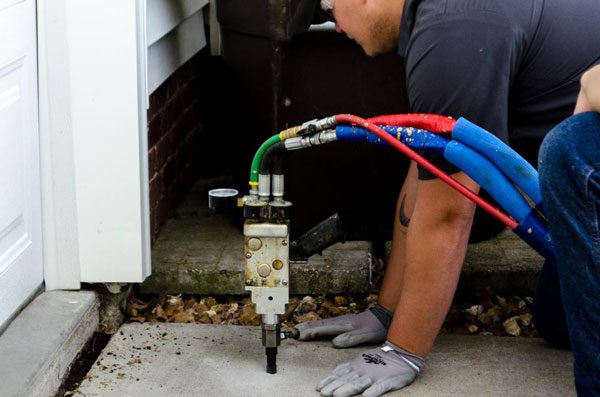
When faced with a sunken concrete surface, pouring more concrete over the affected area might seem like an easy fix. However, this approach will add weight to the already unstable soil, exacerbate the underlying issues, and cause further settlement and cracking over time. Additionally, the new layer of concrete will not bond effectively with the existing slab, leading to a weak and uneven surface that is prone to future damage.
Finally, avoid attempting to level the concrete without proper knowledge or experience. Concrete leveling requires specialized equipment and expertise to achieve accurate results. Hiring a professional ensures the job is done correctly and safely, preventing further damage and costly repairs.
Can You DIY Concrete Leveling?
While the idea of leveling your concrete surfaces yourself may seem appealing, it’s essential to understand the risks involved. One of the primary risks is uneven lifting. Without experience, achieving uniform support across the entire slab can be difficult, leading to an uneven surface and potential further settlement. Worse yet, the slab can be raised too much, and the only remaining solution is to replace the entire slab. Additionally, improper handling of the polyurethane foam can result in inadequate filling of voids, compromising the stability of the leveled surface. DIY attempts may also void any warranties or guarantees provided by professional services, leaving you responsible for future issues.
Hiring a professional for concrete leveling offers several advantages. Professionals have the expertise and experience to accurately assess the condition of your concrete and determine the best approach for leveling. They use specialized equipment to achieve precise lifting and ensure uniform support. Professionals also have access to high-quality materials, guaranteeing the leveled surface remains stable for years. By hiring a professional, you can have peace of mind knowing that the job will be done correctly and that any underlying issues will be addressed. Furthermore, professional services often come with warranties or guarantees, providing additional protection and assurance. In the long run, investing in professional concrete leveling can save you time, money, and stress.
If you’re ready to level your concrete surfaces with expandable foam and enjoy a safer, more attractive home, consider getting a quote from our experts. We service Nebraska and parts of Iowa, Kansas, and Missouri. With over 30 years of experience, you can rest assured that your problem is as good as solved with us.

